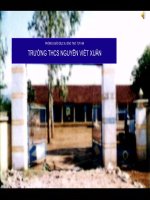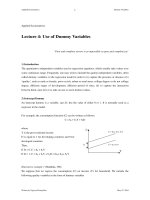SURVEY MEASUREMENT OF WORK DISABILITY docx
Bạn đang xem bản rút gọn của tài liệu. Xem và tải ngay bản đầy đủ của tài liệu tại đây (317.4 KB, 110 trang )
SURVEY MEASUREMENT
OF WORK DISABILITY
Summary of a Workshop
Nancy Mathiowetz and Gooloo S. Wunderlich, Editors
Committee to Review the Social Security Administration’s
Disability Decision Process Research
Dorothy Rice, Chair
Division of Health Care Services
INSTITUTE OF MEDICINE
and
Committee on National Statistics
Commission on Behavioral and Social Sciences and Education
NATIONAL RESEARCH COUNCIL
NATIONAL ACADEMY PRESS
Washington, D.C.
NATIONAL ACADEMY PRESS • 2101 Constitution Avenue, NW • Washington, DC 20418
NOTICE: The project that is the subject of this report was approved by the Governing
Board of the National Research Council, whose members are drawn from the councils of
the National Academy of Sciences, the National Academy of Engineering, and the Insti-
tute of Medicine. The members of the committee responsible for the report were chosen
for their special competences and with regard for appropriate balance.
Support for this project was provided by Contract No. 600-96-27893 between the National
Academy of Sciences and the Social Security Administration. The views presented in this
report are those of the Institute of Medicine Committee to Review the Social Security
Administration’s Disability Decision Process Research and are not necessarily those of the
funding agencies.
International Standard Book Number 0-309-06899-1
Additional copies of this report are available for sale from the National Academy
Press, 2101 Constitution Avenue, NW, Box 285, Washington, DC 20055. Call (800) 624-
6242 or (202) 334-3313 (in the Washington metropolitan area), or visit the NAP’s home
page at www.nap.edu. The full text of this report is available at www.nap.edu/
readingroom.
For more information about the Institute of Medicine, visit the IOM home page at:
www.iom.edu. For more information about the Committee on National Statistics, visit the
CNSTAT home page at www2.nas.edu/cnstat.
Copyright 2000 by the National Academy of Sciences. All rights reserved.
Printed in the United States of America.
The National Academy of Sciences is a private, nonprofit, self-perpetuating society of
distinguished scholars engaged in scientific and engineering research, dedicated to the
furtherance of science and technology and to their use for the general welfare. Upon the
authority of the charter granted to it by the Congress in 1863, the Academy has a mandate
that requires it to advise the federal government on scientific and technical matters. Dr.
Bruce M. Alberts is president of the National Academy of Sciences.
The National Academy of Engineering was established in 1964, under the charter of the
National Academy of Sciences, as a parallel organization of outstanding engineers. It is
autonomous in its administration and in the selection of its members, sharing with the
National Academy of Sciences the responsibility for advising the federal government.
The National Academy of Engineering also sponsors engineering programs aimed at
meeting national needs, encourages education and research, and recognizes the superior
achievements of engineers. Dr. William A. Wulf is president of the National Academy of
Engineering.
The Institute of Medicine was established in 1970 by the National Academy of Sciences
to secure the services of eminent members of appropriate professions in the examination
of policy matters pertaining to the health of the public. The Institute acts under the
responsibility given to the National Academy of Sciences by its congressional charter to
be an adviser to the federal government and, upon its own initiative, to identify issues of
medical care, research, and education. Dr. Kenneth I. Shine is president of the Institute of
Medicine.
The National Research Council was organized by the National Academy of Sciences in
1916 to associate the broad community of science and technology with the Academy’s
purposes of furthering knowledge and advising the federal government. Functioning in
accordance with general policies determined by the Academy, the Council has become the
principal operating agency of both the National Academy of Sciences and the National
Academy of Engineering in providing services to the government, the public, and the
scientific and engineering communities. The Council is administered jointly by both
Academies and the Institute of Medicine. Dr. Bruce M. Alberts and Dr. William A. Wulf
are chairman and vice chairman, respectively, of the National Research Council.
National Academy of Sciences
National Academy of Engineering
Institute of Medicine
National Research Council
COMMITTEE TO REVIEW THE SOCIAL SECURITY
ADMINISTRATION’S DISABILITY DECISION PROCESS RESEARCH
DOROTHY P. RICE (Chair), Professor Emeritus, Department of Social and
Behavioral Sciences, Institute for Health and Aging, University of
California at San Francisco
MONROE BERKOWITZ, Professor of Economics, Emeritus, and Director,
Disability and Health Economics Research, Rutgers University, New
Brunswick, New Jersey
RONALD S. BROOKMEYER, Professor of Biostatistics, The Johns Hopkins
University School of Hygiene and Public Health
GERBEN DEJONG, Director, National Rehabilitation Hospital Research
Center, and Professor of Family Medicine and Adjunct Professor,
Georgetown University Institute of Public Policy, Washington, D.C.
MARSHAL F. FOLSTEIN, Chairman and Professor of Psychiatry, Tufts
University School of Medicine; and Psychiatrist-in-Chief, New England
Medical Center, Boston, Massachusetts
ROBERT M. GROVES, Director of the Joint Program on Survey
Methodology at the University of Maryland at College Park; and Professor
and Program Director, Survey Research Center of the University of
Michigan at Ann Arbor
ALAN M. JETTE, Professor and Dean, Sargent College of Health and
Rehabilitation Sciences, Boston University
WILLIAM D. KALSBEEK, Professor of Biostatistics and Director, Survey
Research Unit, University of North Carolina at Chapel Hill
JERRY L. MASHAW, Sterling Professor of Law and Management and
Professor, Institute for Social and Policy Studies, Yale University
CATHARINE C. MASLOW, Director, Initiative on Alzheimer’s and
Managed Care, Alzheimer’s Association, Washington, D.C.
DONALD L. PATRICK, Professor of Health Services, University of
Washington School of Public Health and Community Medicine
HAROLD A. PINCUS, Senior Scientific Consultant, Robert Wood Johnson
Foundation, the John D. & Catherine T. MacArthur Foundation, and the
RAND Corporation
JOHN A. SWETS, Chief Scientist, Information Sciences, BBN Technologies,
Cambridge, Massachusetts
EDWARD H. YELIN, Professor of Medicine and Health Policy, Department
of Medicine and Institute for Health Policy Studies, University of
California at San Francisco
Study Staff
GOOLOO S. WUNDERLICH, Study Director
KATHLEEN NOLAN, Research Associate
NICOLE AMADO, Senior Project Assistant
iv
v
BOARD ON HEALTH CARE SERVICES
INSTITUTE OF MEDICINE
DON E. DETMER (Chair), Professor of Medical Education in Health
Evaluation Sciences, University of Virginia
BARBARA J. McNEIL (Vice Chair), Ridley Watts Professor, Department of
Health Care Policy, Harvard Medical School
LINDA AIKEN, The Claire M. Fagin Leadership Professor of Nursing and
Professor of Sociology, and Director of the Center for Health Outcomes
and Policy Research, University of Pennsylvania
STUART H. ALTMAN, Sol C. Chaikin Professor of National Health Policy,
The Florence Heller Graduate School for Social Policy, Brandeis
University
HARRIS BERMAN, Chairman and Chief Executive Officer, Tufts Health
Plan, Waltham, Massachusetts
BRIAN BILES, Senior Vice President, The Commonwealth Fund, New York,
New York
CHRISTINE CASSEL, Chairman, Henry L. Schwarz Department of
Geriatrics and Adult Development, Mount Sinai Medical Center, New
York, New York
PAUL D. CLAYTON, Medical Informaticist, Intermountain Health Care, Salt
Lake City, Utah
PAUL F. GRINER, Vice President and Director, Center for the Assessment
and Management of Change in Academic Medicine, Association of
American Medical Colleges, Washington, D.C.
RUBY P. HEARN, Senior Vice President, Robert Wood Johnson Foundation,
Princeton, New Jersey
PETER BARTON HUTT, Partner, Covington and Burling, Washington, D.C.
ROBERT L. JOHNSON, Professor of Pediatrics and Clinical Psychiatry and
Director of Adolescent and Young Adult Medicine, University of
Medicine and Dentistry of New Jersey, New Jersey Medical School
JACQUELINE KOSECOFF, President and Co-Chief Executive Officer,
Protocare, Santa Monica, California
SHEILA T. LEATHERMAN, Executive Vice President, Center for Health
Care Policy and Evaluation, United Health Care Corporation,
Minneapolis, Minnesota
UWE E. REINHARDT, James Madison Professor of Political Economy and
Professor of Economics and Public Affairs, Princeton University
SHOSHANNA SOFAER, Robert P. Luciano Professor of Health Care Policy,
School of Public Affairs, Baruch College
GAIL L. WARDEN, President and Chief Executive Officer, Henry Ford
Health System, Detroit, Michigan
JANET M. CORRIGAN, Director, Board on Health Care Services, IOM
vi
COMMITTEE ON NATIONAL STATISTICS
NATIONAL RESEARCH COUNCIL
JOHN E. ROLPH (Chair), Marshall School of Business, University of
Southern California
JOSEPH G. ALTONJI, Department of Economics, Northwestern University
JULIE DAVANZO, RAND, Santa Monica, California
WILLIAM F. EDDY, Department of Statistics, Carnegie Mellon University
WILLIAM D. KALSBEEK, Survey Research Unit, Department of
Biostatistics, University of North Carolina
RODERICK J. A. LITTLE, School of Public Health, University of Michigan
THOMAS A. LOUIS, Division of Biostatistics, University of Minnesota
CHARLES F. MANSKI, Department of Economics, Northwestern University
WILLIAM D. NORDHAUS, Department of Economics, Yale University
JANET L. NORWOOD, The Urban Institute, Washington, D.C.
EDWARD B. PERRIN, Department of Health Services, University of
Washington
PAUL R. ROSENBAUM, Department of Statistics, The Wharton School,
University of Pennsylvania
FRANCISCO J. SAMANIEGO, Division of Statistics, University of
California at Davis
RICHARD L. SCHMALENSEE, Sloan School of Management,
Massachusetts Institute of Technology
ANDREW WHITE, Acting Director
vii
The Committee to Review the Social Security Administration’s Disability
Decision Process Research (the committee) acknowledges with appreciation the
many people who participated in the Workshop on Survey Measurement of Work
Disability, including those who prepared papers for presentation, those who
served as formal discussants, and the many others who contributed to the lively
and informative discussions at the workshop. Support for the study was provided
by the Social Security Administration. We particularly wish to thank Scott Muller
and Rosanne Hanratty who serve as government project officers for the study.
They provided valuable support for the workshop.
We gratefully acknowledge Nancy Mathiowetz of the Joint Program in Sur-
vey Methodology, University of Maryland, who served as consultant for plan-
ning, organizing, and coediting the summary of the workshop. We acknowledge
with gratitude the commitment and support of the committee staff in organizing
the workshop and preparing the report. Gooloo Wunderlich, Study Director, and
Nancy Mathiowetz not only undertook the major responsibility for the workshop,
but also prepared the report. Kathleen Nolan worked closely with the study
director and the consultant in organizing the workshop, developing the agenda,
and preparing the charts and formatting tables for publication. Rebecca Lucchese,
Senior Project Assistant, assisted in the logistical and administrative arrange-
ments of the workshop. Many thanks go to Nicole Amado, Senior Project Assis-
tant for cheerfully and competently reviewing the drafts, and making editorial
corrections to the entire report, and preparing it for publication under tight dead-
lines. The chair thanks the committee members for their time and commitment to
the workshop.
Acknowledgments
viii
REVIEWERS
The report was reviewed by individuals chosen for their diverse perspectives
and technical expertise in accordance with procedures approved by the National
Research Council’s Report Review Committee. The purpose of this independent
review is to provide candid and critical comments to assist the authors and the
National Academy of Sciences in making the published report as sound as pos-
sible and to ensure that the report meets institutional standards for objectivity,
evidence, and responsiveness to the study charge. The content of the review
comments and the draft manuscript remain confidential to protect the integrity of
the deliberative process.
The committee wishes to thank the following individuals for their participa-
tion in the report review process: Edward Brandt, Jr., University of Oklahoma,
David Keer, National Institute on Disability and Rehabilitation; Cille Kennedy,
National Institute of Mental Health; Mary Grace Kovar, National Opinion Re-
search Center; Janet Norwood, Urban Institute; and Edward Perrin, University of
Washington.
While the individuals listed above provided many constructive comments
and suggestions, responsibility for the final content of the report rests solely with
the authoring committee and the National Academy of Sciences.
Dorothy P. Rice
Chair
ix
1 INTRODUCTION 1
Objectives and Focus of the Workshop, 3
2 CONCEPTUAL ISSUES IN THE MEASUREMENT OF
WORK DISABILITY 4
The Concept of Disability, 5
The Concept of Social Roles, 14
Directionality and the Dynamic Nature of Disability, 18
How Disablement Concepts Differ from Quality of Life and Similar
Concepts, 18
Conceptual Issues Related to the Measurement of Work Disability, 20
Direct Assessment of Work Disability, 24
Conclusion, 27
3 METHODOLOGICAL ISSUES IN THE MEASUREMENT OF
WORK DISABILITY 28
Background, 29
Sources of Error in the Survey Process: The Survey Research
Perspective, 30
Measurement Error: The Psychometric Perspective, 37
Potential Sources of Measurement Error Specific to Persons with
Disabilities, 38
Empirical Evidence Concerning Measurement of Disability Error, 42
Question Wording Issues Related to Selected Measures of Work
Disability, 50
Implications for Methodological Research, 52
Contents
4 SUMMARY OF WORKSHOP DISCUSSIONS 53
Methodological Research on Survey Measurement of Disability, 53
Implications of Different Concepts for Survey Measurement, 56
Sampling, Accessing, and Measuring People with Disabilities, 58
Questionnaire Development Issues for Measures of Work Disability, 60
Role of Environment in Survey Measurement of Disability, 62
5 AN AGENDA FOR RESEARCH IN SURVEY
MEASUREMENT OF WORK DISABILITY 64
Coverage Error, 65
Measurement Error, 66
Nonresponse, 68
Measures of the Environment, 69
Summary, 71
REFERENCES 73
APPENDIXES
A Study Mandate, 77
B Workshop Agenda, 78
C List of Participants, 82
ACRONYMS AND ABBREVIATIONS 91
BIOGRAPHICAL SKETCHES OF COMMITTEE MEMBERS 93
x CONTENTS
SURVEY MEASUREMENT
OF WORK DISABILITY
1
The Social Security Administration (SSA) is engaged in redesigning its dis-
ability determination process for providing cash benefits and medical assistance
to blind and disabled persons under the Social Security Disability Insurance
(SSDI) program and the Supplemental Security Income (SSI) program (Title II
and Title XVI of the Social Security Act). The agency has undertaken a multiyear
research effort to develop and test the feasibility, validity, reliability, and practi-
cality of the redesigned disability determination process before making any deci-
sion about its national implementation.
SSA asked the National Academy of Sciences (NAS) to review and provide
advice on this research. One of the major areas for review is the ongoing indepen-
dent, scientific review of the scope of work, design, and content of the Disability
Evaluation Study (DES) and the conduct of the study by the chosen survey
contractor. NAS has been asked to identify statistical design, methodological,
and content concerns and to address other issues as they arise. (See Appendix A
for the study mandate.) Consistent with this charge is the need for the committee
to ascertain that the methods proposed for measuring disability in the DES,
particularly the approach to one of the DES objectives described below, are
indeed adequate and correct.
SSA’s stated plans regarding ongoing monitoring of the size of the pool of
people who might be potentially eligible for benefits under the SSDI and SSI
programs are to use existing survey vehicles sponsored by other agencies to
supplement a periodic DES. The candidate surveys would be viewed as monitor-
ing tools between periodic comprehensive surveys conducted by SSA. Thus, a
partnership between SSA and other federal data collection agencies would be
forged to provide ongoing monitoring of this population. Such a plan needs an
1
Introduction
2 SURVEY MEASUREMENT OF WORK DISABILITY
initial assessment of the current practices and future challenges for measurement
of disability by use of household surveys.
Across the various surveys now in place, diversity exists in conceptual defi-
nitions of disability, in the nature of reference periods used for recall, in reporting
rules for answering disability questions, in modes of data collection, and in levels
of thresholds used for construction of disability statistics. Furthermore, many of
the measures have not undergone extensive pretesting, such as state-of-the-art
cognitive interviewing methods. Too few methodological inquiries have com-
pared alternative measurement approaches.
The interim reports of the Committee to Review the Social Security Adminis-
tration’s Disability Decision Process Research have provided recommendations
to SSA on the survey design issues faced by the DES. Although this short-run
guidance will be beneficial to the work of SSA, it does not attempt to address
medium- and long-term issues in survey measurement of disability.
As a step toward exploring these issues, the Committee to Review the Social
Security Administration’s Disability Decision Process Research (hereafter re-
ferred to as “the committee”) convened on May 27–28, 1999, a workshop titled
“Survey Measurement of Work Disability: Challenges for Survey Design and
Method.” The committee believed that a focused discussion among a wide range
of disability researchers and survey methodologists could identify unanswered
questions about measurement and provide a framework for a long-term research
agenda in this area for SSA and others in this field. Such a workshop would be
helpful for the committee’s review of the design and content of the DES and
enhance its ability to make informed recommendations to SSA on the subject. It
also could be of great value to SSA in anticipating problems of using data from
other agencies’ surveys to monitor the size of the pool of eligible people.
Workshop participants included members of the committee, a wide range of
researchers in survey design and methods as well as in disability research, and
other invited experts. The workshop, though focused on SSA’s needs, drew the
attention of a large number of disability researchers from other agencies, acade-
mia, and members of the public.
1
The workshop agenda and a list of participants
are shown in Appendixes B and C, respectively.
1
The committee organized the workshop through a planning subcommittee composed of Robert
Groves, Chair, Monroe Berkowitz, Ronald Brookmeyer, William Kalsbeek, Alan Jette, and Dorothy
Rice. Nancy Mathiowetz served as consultant to the Institute of Medicine on the development and
organization of the workshop. The full committee reviewed the plans for the workshop and this
report, and modifications were made in response to the comments received. Thus, the workshop
reflects the collective thinking of the committee regarding the issues discussed.
INTRODUCTION 3
OBJECTIVES AND FOCUS OF THE WORKSHOP
The objectives of this workshop were to:
1. better understand the conceptual issues related to currently existing mea-
sures of work disability, the measurement error properties of these ques-
tions, and the essential survey conditions that affect the measurement of
disability;
2. aid the committee in advising SSA on methods for measuring work dis-
ability in the DES and on ways to facilitate crosswalks between the DES
and data collected in other federal household surveys; and
3. identify a research agenda for SSA in survey measurement of work disability.
The workshop opened with a session in which the authors of the two back-
ground papers presented a “point-counterpoint” dialog.
2
The remaining sessions
for the day focused on measurement and methodological issues within the frame-
work of specific conceptual and programmatic themes. Participants then identi-
fied and discussed issues pertaining to:
• translation of various conceptual models of disability and the disablement
process to valid and reliable questions in a survey and their ability to
address SSA’s disability programmatic requirements;
• measurement error properties of existing measures of work disability and
the survey conditions that affect these measures;
• the ability to crosswalk among measures of disability collected in a variety
of settings, such as the DES, and other ongoing federal data collection
efforts; and
• gaps in the current set of disability measures and the inherent problems in
attempting to fill those gaps.
In the final session of the workshop, participants identified the key issues
that surfaced during the discussions and that could provide a framework for long-
term research to address the gaps in survey methods and measurement of work
disability.
This report includes the commissioned papers written for the workshop and a
summary of the group discussions flowing from the presentations during the subse-
quent sessions outlined in the agenda (Appendix B). The report concludes with a
research agenda identified by the participants during the last day of the workshop.
The summary is limited to the views and opinions of those participating in the
workshop and reflects the concerns and areas of expertise of the workshop partici-
pants. As such, it does not provide a comprehensive review of the research and
current status of survey measurement of work disability. The issues and themes of
the workshop provided the unifying focus for the various presentations and discus-
sions that flowed over the course of the day-and-a-half workshop.
2
The committee commissioned these two papers from Alan M. Jette and Elizabeth Badley and
from Nancy A. Mathiowetz. The committee appreciates their contributions. The papers can be found
in their entirety in Chapters 2 and 3 of this report, respectively.
4 SURVEY MEASUREMENT OF WORK DISABILITY
4
2
Conceptual Issues in the Measurement of
Work Disability
Alan M. Jette
Boston University’s Sargent College of Health and
Rehabilitation Sciences
Elizabeth Badley
Arthritis Community Research and Evaluation Unit
The University Health Network, Toronto, Ontario, Canada
The field of disability research is in need of uniform concepts and a common
language to guide scholarly discussion, to advance theoretical work on the dis-
ablement process, to facilitate future survey and epidemiological research, and to
enhance understanding of disability on the part of professionals as well as the
general public. A commonly understood language can also influence the develop-
ment of public policy in the area of work disability, the focus of the Institute of
Medicine’s workshop titled “Survey Measurement of Work Disability.” The cur-
rent lack of a uniform language and commonly understood definition of the
concepts of “disability” and “work disability” is a serious obstacle to all these
endeavors.
Conceptual confusion is a particular barrier to the improvement of the Social
Security Administration’s (SSA) process for determining eligibility for both So-
cial Security Disability Insurance (SSDI) and Supplemental Security Income
(SSI) related to “work disability,” as was illustrated in the earlier Institute of
Medicine workshop, “Measuring Functional Capacity and Work Requirements.”
A shared language and conceptual understanding did not emerge from that work-
shop. If various participants in the disability benefit determination revision pro-
cess cannot agree on the meaning of the term “work disability,” they can hardly
be expected to reach agreement on an approach to improving the work disability
determination process.
The Social Security Act defines disability as the “inability to engage in any
substantial gainful activity by reason of a medically determinable physical or
mental impairment which can be expected to result in death or can be expected to
last for a continuous period of not less than 12 months.” As this background
CONCEPTUAL ISSUES IN THE MEASUREMENT OF WORK DISABILITY 5
paper will illustrate, this definition in the Social Security Act is at odds with most
contemporary thought about the concept of disability and is in itself a barrier to
the SSA’s work disability revision process.
The paper presented in this chapter aims to provide the reader with a concep-
tual foundation to facilitate discussion at the upcoming workshop titled “Survey
Measurement of Work Disability.” Our intent is to highlight issues regarding
language and concepts directly or indirectly related to the concept of “work
disability.” To do so, we focus on several activities:
1. present a review of some of the contemporary definitions of disability
found in the literature;
2. discuss these definitions in the context of several major disablement
frameworks;
3. discuss the concept of “work disability” in the context of these disable-
ment models and relate it to other health-related phenomena;
4. critically review the conceptual basis of frequently used survey items that
attempt to assess “work disability”; and
5. highlight some of the pressing research needs in the area of “work disability.”
THE CONCEPT OF DISABILITY
A common understanding of the term “disability” is an essential first step to
a scholarly exchange about the concept of “work disability” and is the foundation
for a fruitful discussion of improving survey research in the general area of
disability and, more specifically, in the area of work disability.
Understanding of the source of contemporary conceptual confusion requires
a review of the major disability frameworks found in the literature. The goal of
bringing together the several different schools of thought on disability and the
disablement process remains elusive. Achieving a commonly accepted concep-
tual language is one of the primary challenges facing the field of disability
research.
Major Schools of Thought
Several schools of thought have defined disability and related concepts. We
will focus on the Disablement Model developed by Nagi (1965) and the Interna-
tional Classification of Impairments, Disabilities, and Handicaps (ICIDH-1)
(WHO, 1980) and the current proposal for its revision, which is referred to in this
chapter as ICIDH-2 (WHO, 1997). We will briefly review both of these concep-
tual frameworks. Both the Nagi Disablement Model and ICIDH frameworks have
in common the view that overall disablement represents a series of related con-
cepts that describe the consequences or impact of a health condition on a person’s
body, on a person’s activities, and on the wider participation of that person in
6 SURVEY MEASUREMENT OF WORK DISABILITY
society. In the authors’ view, the major differences in these frameworks are in the
terms used to describe disability and related concepts and the placement of the
boundaries between concepts more than differences in their fundamental con-
tents. After reviewing the terms within each framework we will compare and
contrast the two major models along with their major derivatives and explore
how these relate more generally to the concept of “work disability.”
Nagi’s Concept of Disability
According to the conceptual framework of disability developed by sociolo-
gist Saad Nagi (1965), “disability is the expression of a physical or a mental
limitation in a social context.” In striking contrast to the Social Security Act’s
definition of work disability as an inability to work due to a physical or mental
impairment, Nagi specifically views the concept of disability as representing the
gap between a person’s capabilities and the demands created by the social and
physical environments (Nagi, 1965, 1976, 1991). This is a fundamental distinc-
tion of critical importance to scholarly discussion and research related to disabil-
ity phenomena.
According to Nagi’s own words:
[Disability is a] limitation in performing socially defined roles and tasks ex-
pected of an individual within a sociocultural and physical environment. These
roles and tasks are organized in spheres of life activities such as those of the
family or other interpersonal relations; work, employment, and other economic
pursuits; and education, recreation, and self-care. Not all impairments or func-
tional limitations precipitate disability, and similar patterns of disability may
result from different types of impairments and limitations in function. Further-
more, identical types of impairments and similar functional limitations may
result in different patterns of disability. Several other factors contribute to shap-
ing the dimensions and severity of disability. These include (a) the individual’s
definition of the situation and reactions, which at times compound the limita-
tions; (b) the definition of the situation by others, and their reactions and expec-
tations—especially those who are significant in the lives of the person with the
disabling condition (e.g., family members, friends and associates, employers
and co-workers, and organizations and professions that provide services and
benefits); and (c) characteristics of the environment and the degree to which it
is free from, or encumbered with, physical and sociocultural barriers. (Nagi,
1991, p. 315)
Nagi’s definition stipulates that a disability may or may not result from the
interaction of an individual’s physical or mental limitations with the social and
physical factors in the individual’s environment. Consistent with Nagi’s concept
of disability, an individual’s physical and mental limitations would not invariably
lead to work disability. Not all physical or mental conditions would precipitate a
work disability, and similar patterns of work disability may result from different
CONCEPTUAL ISSUES IN THE MEASUREMENT OF WORK DISABILITY 7
types of health conditions. Furthermore, identical physical and mental limitations
may result in different patterns of work disability.
Nagi’s Disablement Model has its origins in the early 1960s. As part of a
study of decision making in the SSDI program, Nagi (1964) constructed a frame-
work that differentiated disability (as defined and discussed above) from three
other distinct yet interrelated concepts: active pathology, impairment, and func-
tional limitation. This conceptual framework has come to be referred to as Nagi’s
Disablement Model.
For Nagi, active pathology involves the interruption of normal cellular pro-
cesses and the simultaneous homeostatic efforts of the organism to regain a
normal state. He notes that active pathology can result from infection, trauma,
metabolic imbalance, degenerative disease processes, or other etiology. Examples
of active pathology are the cellular disturbances consistent with the onset of
disease processes such as osteoarthritis, cardiomyopathy, and cerebrovascular
accidents.
For Nagi, impairment refers to a loss or abnormality at the tissue, organ, and
body system level. Active pathology usually results in some type of impairment,
but not all impairments are associated with active pathology (e.g., congenital loss
or residual impairments resulting from trauma). Impairments can occur in the
primary locale of the underlying pathology (e.g., muscle weakness around an
osteoarthritic knee joint), but they may also occur in secondary locales (e.g.
cardiopulmonary deconditioning secondary to inactivity).
To describe the distinct consequences of pathology at the level of the indi-
vidual, Nagi uses the term functional limitations to represent restrictions in the
basic performance of the person. An example of basic functional limitations that
might result from a cerebrovascular accident could include limitations in the
performance of locomotor tasks, such as the person’s gait and basic mobility,
such as transfers, or in nonphysical tasks, such as communication or reasoning.
Such functional limitations might or might not be related to specific impairments
(secondary to the cerebrovascular accident) and thus are seen as distinct from
organ or body system disturbances.
At this point, a “work disability” example will illustrate the distinctions
being drawn between the various concepts within Nagi’s Disablement Model.
Two patients with Parkinson’s disease may enter the Social Security work dis-
ability benefits determination process with very similar clinical profiles. Both
may have moderate impairments such as rigidity and bradykinesia. Their patterns
of function may also be similar with a characteristically slow, shuffling gait, and
slow deliberate movement patterns. Their work role patterns, however, may be
radically different. One individual may have restricted his or her outside activi-
ties completely, need help dressing in the morning, spend most of the time in-
doors watching television, be depressed, and be currently unemployed. The other
may be fully engaged in his or her social life, receive assistance from a spouse in
performing daily activities, be driven to work, and, through workplace modifica-
8 SURVEY MEASUREMENT OF WORK DISABILITY
tion, be able to maintain full-time employment. The two patients present very
different work disability profiles yet have very similar underlying pathology,
impairment, and functional limitation profiles.
Elaboration of Nagi’s Disablement Model
In their work on the disablement process, Verbrugge and Jette (1994) main-
tained the basic concepts of the Nagi Disablement Model and Nagi’s original
definitions. Within the dimension of disability, however, they categorized sub-
dimensions of social roles that can be considered under Nagi’s concept of disabil-
ity. Some of the most commonly applied dimensions include the following:
• Activities of daily living (ADL)—including behaviors such as basic mobil-
ity and personal care.
• Instrumental activities of daily living (IADL)—including activities such
as preparing meals, doing housework, managing finances, using the tele-
phone, and shopping.
• Paid and unpaid role activities—including performing one’s occupation,
parenting, grandparenting, and being a student.
• Social activities—including attending church and other group activities
and socializing with friends and relatives.
• Leisure activities—including participating in sport and physical recre-
ation, reading, or taking distant trips.
Within their framework, “work disability” is clearly delineated as a specific
subdimension under the concept of disability.
In their 1994 work, Verbrugge and Jette attempted to extend Nagi’s Disable-
ment Model to attain full sociomedical scope. They attempted to clearly differen-
tiate the “main pathways” of the disablement process (i.e., Nagi’s original con-
cepts) from factors hypothesized or known to influence the ongoing process of
disablement (Figure 2-1).
Viewed from a social epidemiological perspective, Verbrugge and Jette
(1994) argued that one might analyze differences in disablement concepts rela-
tive to three sets of variables: predisposing risk factors, intraindividual factors,
and extraindividual factors. These categories of variables, which are external to
the main disablement pathway, can be defined as follows:
• Risk factors are predisposing phenomena that are present before the onset
of the disabling event and that can affect the presence or severity of the
disablement process. Examples include sociodemographic background,
lifestyle, and biological factors.
• The next class of variables is intraindividual factors (those that operate
within a person), such as lifestyle and behavioral changes, psychosocial
attributes and coping skills, and activity accommodations made by the
individual after the onset of a disabling condition.
CONCEPTUAL ISSUES IN THE MEASUREMENT OF WORK DISABILITY 9
FIGURE 2-1. The disablement process. SOURCE: Adapted from Verbrugge and Jette,
1994.
LIFESTYLE AND BEHAVIOR CHANGES
(overt changes to alter disease activity and
impact)
PSYCHOSOCIAL ATTRIBUTES AND COPING
(positive affect, emotional vigor, prayer, locus
of control, cognitive adaptation to one's
situation, confidant, peer support groups, etc.)
ACTIVITY ACCOMMODATIONS
(changes in kinds of activities, procedures for
doing them, frequency or length of time doing
them)
INTRAINDIVIDUAL FACTORS:
RISK
FACTORS
MEDICAL CARE AND REHABILITATION
(surgery, physical therapy, speech therapy, counseling, health
education, job retraining, etc.)
MEDICATIONS AND OTHER THERAPEUTIC REGIMENS
(drugs, recreational therapy/aquatic exercise,
biofeedback/meditation, rest/energy conservation, etc.)
EXTERNAL SUPPORTS
(personal assistance, special equipment and devices, standby
assistance/supervision, day care, respite care, meals-on-wheels, etc.)
BUILT, PHYSICAL, AND SOCIAL ENVIRONMENTS
(structural modifications at job/home, access to buildings and to
public transportation, improvement of air quality, reduction of noise
and glare, health insurance and access to medical care, laws and
regulations, employment discrimination, etc.)
THE MAIN PATHWAY
(diagnoses of
disease, injury,
congenital/
developmental
condition)
(predisposing
characteristics:
demographic, social,
lifestyle, behavioral,
psychological,
environmental,
biological)
(dysfunction and
structural abnormalities
in specific body systems:
musculoskeletal,
cardiovascular,
neurological, etc.)
(restrictions in basic
physical and mental
actions: ambulate,
reach, stoop, climb
stairs, produce
intelligible speech, see
standard print, etc.)
(difficulty doing activities of
daily life: job, household
management, personal care,
hobbies, active recreation,
clubs, socializing with
friends and kin, child care,
errands, sleep, trips, etc.)
PATHOLOGY
IMPAIRMENTS
DISABILITY
FUNCTIONAL
LIMITATIONS
EXTRAINDIVIDUAL FACTORS:
10 SURVEY MEASUREMENT OF WORK DISABILITY
• Extraindividual factors (those that perform outside or external to the per-
son) pertain to the physical as well as the social context in which the
disablement process occurs. Environmental factors relate to the social as
well as the physical environmental factors that bear on the disablement
process. These can include medical and rehabilitation services, medica-
tions and other therapeutic regimens, external supports available in the
person’s social network, and the physical environment.
A further elaboration of Nagi’s conceptual view of the term disability is
contained in Disability in America (IOM, 1991) and a more recent Institute of
Medicine (IOM) disablement model revision highlighted in a report titled En-
abling America: Assessing the Role of Rehabilitation Science and Engineering
(IOM, 1997).
The 1991 IOM report uses the original main disablement pathways put forth
by Nagi with minor modifications of his original definitions. The 1997 IOM
report adds two important concepts to the Disablement Model: the concepts of
secondary conditions and quality of life. Both of these concepts are discussed
later in this chapter.
In 1997, in an effort to emphasize Nagi’s view that disability is not inherent
in the individual (as defined by the Social Security Act), but, rather, is a product
of the interaction of the individual with the environment, IOM issued Enabling
America, in which it referred to disablement as “the enabling-disabling process.”
This effort was an explicit attempt to acknowledge, within the disablement frame-
work itself, that disabling conditions not only develop and progress but can be
reversed through the application of rehabilitation and other forms of explicit
intervention. Figure 2-2 is an illustration of IOM’s 1997 enabling-disabling
process.
The IOM report (1997) describes the enabling-disabling process as follows:
Access to the environment, depicted as a square, represents both physical space
and social structures (family, community, society). The person’s degree of phys-
ical access to and social integration into the generalized environment is shown
as the degree of overlap of the symbolic person and the environmental square.
A person who does not manifest disability (Figure 2-2a) is fully integrated into
society and has full access to both: (1) social opportunities (e.g., employment,
education, parenthood, leadership roles) and (2) physical space (e.g., housing,
workplaces, transportation). A person with disabling conditions has increased
needs (shown as the increased size of the individual) and is dislocated from
their prior integration into the environment (Figure 2-2b). The enabling (or
rehabilitative) process attempts to rectify this displacement, either by restoring
function in the individual (Figure 2-2c) or by expanding access to the environ-
ment (Figure 2-2d) (e.g., building ramps). (IOM, 1997, p. 3)
11
FIGURE 2-2. Conceptual overview of the enabling-disabling process. The environment, depicted as a square, represents both physical
space and social structures (family, community, society). A person who does not manifest a disability (a) is fully integrated i
nto
society and “fits within the square.
” A person with potentially disabling conditions has increased needs (expressed by the size of the
individual) and is dislocated from his or her prior integration into the environment (b), that is,
“doesn’t fit in the square.
” The enabling
(or rehabilitative) process attempts to rectify this displacement, either by restoring function in the individual (c) or by exp
anding
access to the environment (d) (e.g., building ramps). SOURCE: Reprinted from IOM, 1997.
Disabling Process
Person's needs
enlarge relative to
existing environment
Environmental
Modification
Ramps; universal
design
Enabling
Process
Functional
Restoration
Neural repair;
Range of motion;
Artificial hip replacement
Restore a person's
functionality
“Enlarge” the environment
to make it more accessible
The Environment
(physical and social)
The “person” in the
“environment”
a
b
d
c
12 SURVEY MEASUREMENT OF WORK DISABILITY
International Classification of Impairments, Disabilities, and Handicaps
Independently from the development of the Nagi model, a similar process
was also under way in Europe, which led in the early 1970s to the first draft of
what later became the World Health Organization (WHO) ICIDH (WHO, 1980).
This model also differentiates a series of related concepts: health conditions,
impairments, disabilities, and handicaps (WHO, 1980; Badley, 1993). We will
refer to these as the ICIDH-1 concepts. ICIDH-1 is not only a conceptual model;
it has also associated with it a hierarchical classification of impairment, disabil-
ity, and handicap (WHO, 1980). We will not review this classification as such,
except to note that, in principle, this system provides a scheme for coding and
manipulating data on the consequences of health conditions. This classification
and the related model of disablement are being revised and have been named
ICIDH-2. At the time of this writing (April 1999), a first, beta draft has been
circulated for comment (WHO, 1997), and the beta-2 draft is in the final stages of
production. The beta-2 draft revised classification will then undergo 2 years of
field testing before the final version is prepared for ratification by the WHO. The
changes in the definitions and conceptual model that are being recommended in
the process of revision to get ICIDH-2 are discussed below. The U.S. National
Center for Health Statistics and the Centers for Disease Control and Prevention
have served as the lead U.S. agencies in the international ICIDH revision process.
The first component of the ICIDH-1 model is impairment, which is defined
as follows:
In the context of health experience, an impairment is any loss or abnormality of
psychological, physiological, or anatomical structure or function. (WHO, 1980,
p. 27)
This definition is similar to Nagi’s definition of impairment, but it also includes
some of Nagi’s notions of pathology. Just as Nagi’s impairment is focused on
organs or organ systems, impairment as defined here is very much concerned
with the function and structure of the body and its components. The ICIDH-2
definition is similar:
Impairment is a loss or abnormality of body structure or of a physiological or
psychological function. (WHO, 1997, p. 15)
Huge confusion arises because the ICIDH-1 also uses the word disability,
but with a slightly different meaning from the Nagi definition of the term. The
ICIDH-1 defines disability as follows:
In the context of health experience, a disability is any restriction or lack (result-
ing from an impairment) of ability to perform an activity in the manner or
within the range considered normal for a human being. (WHO, 1980, p. 28)
The focus of this definition is very much on the activities carried out by the
person. Further understanding of what is included in this definition can be gained









